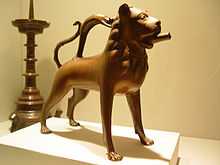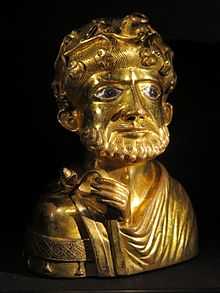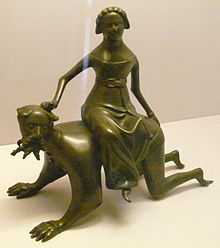Aquamanile

In modern usage, an aquamanile (plural aquamanilia or simply aquamaniles) is a ewer or jug-type vessel in the form of one or more animal or human figures. It usually contained water for the washing of hands (aqua + manos) over a basin, which was part of both upper-class meals and the Christian Eucharist. Historically the term was sometimes used for any shape of basin or ewer so used, regardless of shape. Most surviving examples are in metal, typically copper alloys (brass or bronze), as pottery versions have rarely survived.
Islamic art
Persian aquamaniles predate any zoomorphic aquamaniles known in Europe. An Iranian (Abbasid caliphate), Aquamanile in the form of an eagle, bearing the date 180 AH/CE 796-797, of bronze, inlaid with silver and copper, is in the State Hermitage Museum, St. Petersburg. Among the latest in date is one also at the State Hermitage Museum, a late Islamic aquamanile from Khorasan, dated 1206. Islamic law deprecated the use of such representational figures, and the Islamic zoomorphic aquamanile tradition died out.
However the tradition was taken up enthusiastically in Europe, where the form remained popular until the Renaissance.
Europe

The Byzantine Empire's cultural connections with Sassanid Persia and the Abbasid caliphate, never peaceful in the political sphere, nevertheless brought the aquamanile into the Christian Mediterranean world. The earliest European portable aquamaniles date to the eleventh century.
Ewers and basins were needed in Christian liturgy for the ritual of the lavabo, in which the officiating priest washes his hands before vesting, again before the consecration of the Eucharist and after mass. As a ritual object, metal was considered more suitable than pottery, although most examples in pottery no doubt were broken and discarded. The aquamaniles made in the Mosan – or Meuse valley – region, using the brass alloy of silvery tint called dinanderie (from the center of its manufacture in the region of Dinant) were often fantastic and zoomorphic in their forms, which were constrained only by the need for a larger opening for filling the vessel and a spout for pouring. Church records inventory aquamaniles in silver or gilt copper, but the great majority of surviving examples are in base metals, which were not worth melting down.
European lore around lions
There are two kinds of lion: one is timid, has a short body and curly hair; the other has straight hair, a long body and is fierce in appearance. A lion's strength is seen in its chest, its firmness in its head, and its courage in its forehead and tail. There are three main natures of the lion, each have a meaning that come from Christianity. "The lion erasing its tracks with its tail represents the way Jesus concealed his divinity, only revealing himself to his followers. The lion sleeping with its eyes open represents Jesus, physically dead after crucifixion, but still spiritually alive in his divine nature. The lion roaring over his dead cubs to bring them to life represents how God the father woke Jesus after three days in his tomb." (Beastiary)
_01.jpg)

As well as the altar, aquamaniles were used at the tables of the great, where extravagant designs of symbolic or fantastical beasts – lions were especially popular – were developed in purely secular iconography. A gold aquamanile, c. 1215, in the treasury of the cathedral at Aachen, takes the form of a man's bust; it is a rare survival of an aquamanile in a precious metal. An aquamanile (ref. Metropolitan Museum) in the form of Aristotle on hands and knees, being ridden by Phyllis, bore several moral lessons, with ribald undertones; such an aquamanile was distinctly secular in nature.
Bronze aquamaniles in the form of leopards were part of court ritual in Benin, where the concept may have arrived from the Islamic north. An 18th-century bronze leopard aquamanile from Benin is in the collection of the Minneapolis Institute of Arts.
From the Renaissance elaborate versions of the conventional ewer were preferred to zoomorphic forms. A late version of the aquamanile was the silver-gilt mounted rider on a stand, bought in 1700 for the treasury of the Basilica of St-Denis and sold in 1798. Its form is recorded in an engraving by Félibien. (ref. St-Denis) The idea of ewers in fantastic shapes has never died out.
Examples

The following aquamanilia in public collections are set in approximate chronological order:
- State Hermitage Museum, Aquamanile in the form of an eagle, signed by "Suleiman" dated 180 AH/796-797
- State Hermitage Museum, aquamanile of a cow with her calf, Khorasan, dated CE 1206; the handle is in the form of a lion, attacking the cow by the hump of its back.
- Victoria and Albert Museum, Aquamanile in the form of a griffin, ca 1130
- National Gallery of Art, Washington, Aquamanile in the form of a lion, bronze with traces of gilding, North French or Mosan, c 1300*National Gallery of Art, Washington DC, Aquamanile in the form of a mounted horseman, English or Scandinavian, 13th century
- Rijksmuseum, Aquamanile in the form of a horse, bronze, Maas/Meuse region, 13th century
- Wartburg, Eisenach, Aquamanile in the form of a lion, 13th century
- Metropolitan Museum of Art, Aquamanile in the form of a mounted knight, bronze, Saxony, late 13th century
Legion of Honor,San Francisco, Aquamnile of a lion, German, 13th century
- Metropolitan Museum of Art, Aquamanile in the form of Aristotle and Phyllis, Lorraine, c 1400
- The Cloisters Collection, Aquamanile in the form of a lion, copper alloy, Nuremberg, c 1400
- Rijksmuseum, Aquamanile in the form of a lion, last quarter of the 14th century
- "The Treasure of Saint Denis"
- Circa 1665, Aquamanile Shaped like a Rider from Augsburg, Germany (Hermitage Museum).[1]
See also
- Bartmann jugs, also known as Bellarmine jubs, pottery jugs with bearded faces manufactured in Europe in 16th and 17th centuries.
- Toby jug, pottery jug in the form of a seated person, or the head.
- Cow creamer, ceramic or silver cream dispenser in the shape of a cow.
References
- Legner, Anton (ed). Ornamenta Ecclesiae, Kunst und Künstler der Romanik. Catalogue of an exhibition in the Schnütgen Museum, Köln, 1985. 3 vols.
- "Lion" entry in The Medieval Bestiary
Notes
- ↑ "Aquamanile Shaped like a Rider". Hermitage Museum.
Further reading
- Barnet, Peter; Dandridge, Pete (2006). Lions, Dragons, & other Beasts: Aquamanilia of the Middle Ages: Vessels for Church and Table. (Bard Graduate Center for Studies in the Decorative Arts, Design & Culture). Yale University Press. ISBN 978-0-300-11684-7.
- Ettinghausen, Elizabeth S. (2007). "Analysing a Pictorial Narrative The Aquamanile in the Hermitage Museum in St Petersburg". In Jens Kröger, Annette Hagedorn, Avinoam Shalem. Facts and artefacts: art in the Islamic. Islamic history and civilization: Studies and texts 68. Brill. ISBN 978-90-04-15782-8.
- Grabar, Oleg (2002). "About a bronze bird". In Sears, Elizabeth; Thomas, Thelma K. Reading medieval images : the art historian and the object. Ann Arbor: University of Michigan Press. pp. 117–125. ISBN 0-472-09751-2.
- Gross, Uwe (1983). "Das Aquamanile der "rotbemalten Feinware" aus Speyer". Pfälzer Heimat (in German). 4/1983: 145–155.
External links
- European sculpture and metalwork, a collection catalog from The Metropolitan Museum of Art Libraries (fully available online as PDF), which contains material on aquamanile (see index)
| Wikimedia Commons has media related to Aquamanile. |